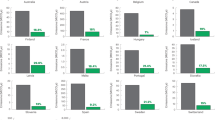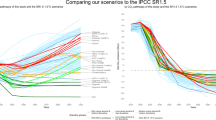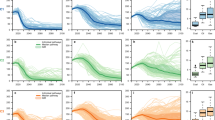Abstract
Current emission pledges to the Paris Agreement appear insufficient to hold the global average temperature increase to well below 2 °C above pre-industrial levels1. Yet, details are missing on how to track progress towards the ‘Paris goal’, inform the five-yearly ‘global stocktake’, and increase the ambition of Nationally Determined Contributions (NDCs). We develop a nested structure of key indicators to track progress through time. Global emissions2,3 track aggregated progress1, country-level decompositions track emerging trends4,5,6 that link directly to NDCs7, and technology diffusion8,9,10 indicates future reductions. We find the recent slowdown in global emissions growth11 is due to reduced growth in coal use since 2011, primarily in China and secondarily in the United States12. The slowdown is projected to continue in 2016, with global CO2 emissions from fossil fuels and industry similar to the 2015 level of 36 GtCO2. Explosive and policy-driven growth in wind and solar has contributed to the global emissions slowdown, but has been less important than economic factors and energy efficiency. We show that many key indicators are currently broadly consistent with emission scenarios that keep temperatures below 2 °C, but the continued lack of large-scale carbon capture and storage13 threatens 2030 targets and the longer-term Paris ambition of net-zero emissions.
This is a preview of subscription content, access via your institution
Access options
Access Nature and 54 other Nature Portfolio journals
Get Nature+, our best-value online-access subscription
$29.99 / 30 days
cancel any time
Subscribe to this journal
Receive 12 print issues and online access
$209.00 per year
only $17.42 per issue
Buy this article
- Purchase on Springer Link
- Instant access to full article PDF
Prices may be subject to local taxes which are calculated during checkout





Similar content being viewed by others
References
Rogelj, J. et al. Paris Agreement climate proposals need a boost to keep warming well below 2 °C. Nature 534, 631–639 (2016).
The Emissions Gap Report 2015 (United Nations Environment Programme, 2015).
Le Quéré, C. et al. Global Carbon Budget 2016. Earth Syst. Sci. Data 8, 605–649 (2016).
Raupach, M. R. et al. Global and regional drivers of accelerating CO2 emissions. Proc. Natl Acad. Sci. USA 104, 10288–10293 (2007).
Blanco, G. et al. in Climate Change 2014: Mitigation of Climate Change (eds Edenhofer, O. et al.) (IPCC, Cambridge Univ. Press, 2014).
Steckel, J. C., Edenhofer, O. & Jakob, M. Drivers for the renaissance of coal. Proc. Natl Acad. Sci. USA 112, E3775–E3781 (2015).
Synthesis Report on the Aggregate Effect of the Intended Nationally Determined Contributions (United Nations Framework Convention on Climate Change, 2015).
Nykvist, B. & Nilsson, M. Rapidly falling costs of battery packs for electric vehicles. Nat. Clim. Change 5, 329–332 (2015).
Wilson, C., Grubler, A., Gallagher, K. S. & Nemet, G. F. Marginalization of end-use technologies in energy innovation for climate protection. Nat. Clim. Change 2, 780–788 (2012).
World Energy Investment Outlook (International Energy Agency, 2014).
Jackson, R. B. et al. Reaching peak emissions. Nat. Clim. Change 6, 7–10 (2016).
Qi, Y., Stern, N., Wu, T., Lu, J. & Green, F. China’s post-coal growth. Nat. Geosci. 9, 564–566 (2016).
Reiner, D. M. Learning through a portfolio of carbon capture and storage demonstration projects. Nat. Energy 1, 15011 (2016).
Peters, G. P., Andrew, R. M., Solomon, S. & Friedlingstein, P. Measuring a fair and ambitious climate agreement using cumulative emissions. Environ. Res. Lett. 10, 105004 (2015).
Feng, K., Davis, S. J., Sun, L. & Hubacek, K. Drivers of the US CO2 emissions 1997–2013. Nat. Commun. 6, 7714 (2015).
World Energy Outlook 2015 (International Energy Agency, 2015).
Global Economic Prospects, June 2016: Divergences and Risks (World Bank, 2016).
Peters, G. P. et al. Rapid growth in CO2 emissions after the 2008–2009 global financial crisis. Nat. Clim. Change 2, 2–4 (2012).
Galiana, I. & Green, C. Let the global technology race begin. Nature 462, 570–571 (2009).
Clarke, L. et al. in Climate Change 2014: Mitigation of Climate Change (eds Edenhofer, O. et al.) 413–510 (IPCC, Cambridge Univ. Press, 2014).
Ang, B. W. & Su, B. Carbon emission intensity in electricity production: a global analysis. Energy Policy 94, 56–63 (2016).
Kotchen, M. J. & Mansur, E. T. Correspondence: Reassessing the contribution of natural gas to US CO2 emission reductions since 2007. Nat. Commun. 7, 10648 (2016).
Shearer, C., Ghio, N., Myllyvirta, L., Yu, A. & Nace, T. Boom and Bust 2016: Tracking the Global Coal Plant Pipeline (CoalSwarm, Sierra Club, and Greenpeace, 2016).
Davis, S. J., Matthews, D. & Caldeira, K. Future CO2 emissions and climate change from existing energy infrastructure. Science 329, 1330–1335 (2010).
Anderson, K. & Peters, G. The trouble with negative emissions. Science 354, 182–183 (2016).
Fuss, S. et al. Betting on negative emissions. Nat. Clim. Change 4, 850–853 (2014).
Creutzig, F. et al. Bioenergy and climate change mitigation: an assessment. GCB Bioenerg. 7, 916–944 (2014).
Canadell, J. G. & Schulze, E. D. Global potential of biospheric carbon management for climate mitigation. Nat. Commun. 5, 5282 (2014).
The Global Status of CCS: 2015 (Global CCS Institute, 2015).
Buck, H. J. Rapid scale-up of negative emissions technologies: social barriers and social implications. Climatic Change 139, 155–167 (2016).
Peters, G. P. The ‘best available science’ to inform 1.5 °C policy choices. Nat. Clim. Change 6, 646–649 (2016).
Smith, P. et al. Biophysical and economic limits to negative CO2 emissions. Nat. Clim. Change 6, 42–50 (2015).
Chen, C. & Tavoni, M. Direct air capture of CO2 and climate stabilization: a model based assessment. Climatic Change 118, 59–72 (2013).
Krey, V. et al. in Climate Change 2014: Mitigation of Climate Change (eds Edenhofer, O. et al.) (IPCC, Cambridge Univ. Press, 2014).
Hoekstra, R. & van der Bergh, J. C. J. M. Comparing structural and index decomposition analysis. Energy Econ. 25, 39–64 (2003).
Su, B. & Ang, B. W. Structural decomposition analysis applied to energy and emissions: some methodological developments. Energy Econ. 34, 177–188 (2012).
Boden, T. A., Andres, R. J. & Marland, G. Global, Regional, and National Fossil-Fuel CO2 Emissions in Trends (Carbon Dioxide Information Analysis Center, Oak Ridge National Laboratory US, Department of Energy, 2016).
BP Statistical Review of World Energy June 2016 (BP, 2016); bp.com/statisticalreview
Korsbakken, J. I., Peters, G. P. & Andrew, R. M. Uncertainties around reductions in China’s coal use and CO2 emissions. Nat. Clim. Change 6, 687–690 (2016).
Bailis, R., Drigo, R., Ghilardi, A. & Masera, O. The carbon footprint of traditional woodfuels. Nat. Clim. Change 5, 266–272 (2015).
National Accounts Main Aggregates Database (United Nations, 2015); http://unstats.un.org/unsd/snaama/Introduction.asp
Adoption of the Paris Agreement FCCC/CP/2015/L.9/Rev.1 (United Nations Framework Convention on Climate Change, 2015).
Short-term Energy Outlook (US Energy Information Administration, 2016).
Acknowledgements
G.P.P., R.M.A. and J.I.K. acknowledge the support of the Research Council of Norway (projects 569980 & 209701). J.G.C. is grateful for the support of the National Environmental Science Program—Earth Systems and Climate Change (NESP-ESCC) Hub.
Author information
Authors and Affiliations
Contributions
G.P.P., J.G.C. and C.L.Q. designed the research; G.P.P. and R.M.A. performed the analysis; all analysed the results; all wrote the paper.
Corresponding author
Ethics declarations
Competing interests
The authors declare no competing financial interests.
Supplementary information
Supplementary Information
Supplementary Information (PDF 1740 kb)
Rights and permissions
About this article
Cite this article
Peters, G., Andrew, R., Canadell, J. et al. Key indicators to track current progress and future ambition of the Paris Agreement. Nature Clim Change 7, 118–122 (2017). https://doi.org/10.1038/nclimate3202
Received:
Accepted:
Published:
Issue Date:
DOI: https://doi.org/10.1038/nclimate3202
This article is cited by
-
Global food loss and waste estimates show increasing nutritional and environmental pressures
Nature Food (2024)
-
Revisiting Copenhagen climate mitigation targets
Nature Climate Change (2024)
-
Potentiometry of wind, solar and geothermal energy resources and their future perspectives in Iran
Environment, Development and Sustainability (2024)
-
Carbon footprints of the equity portfolios of Chinese fund firms
Communications Earth & Environment (2023)
-
The narrowing gap in developed and developing country emission intensities reduces global trade’s carbon leakage
Nature Communications (2023)



